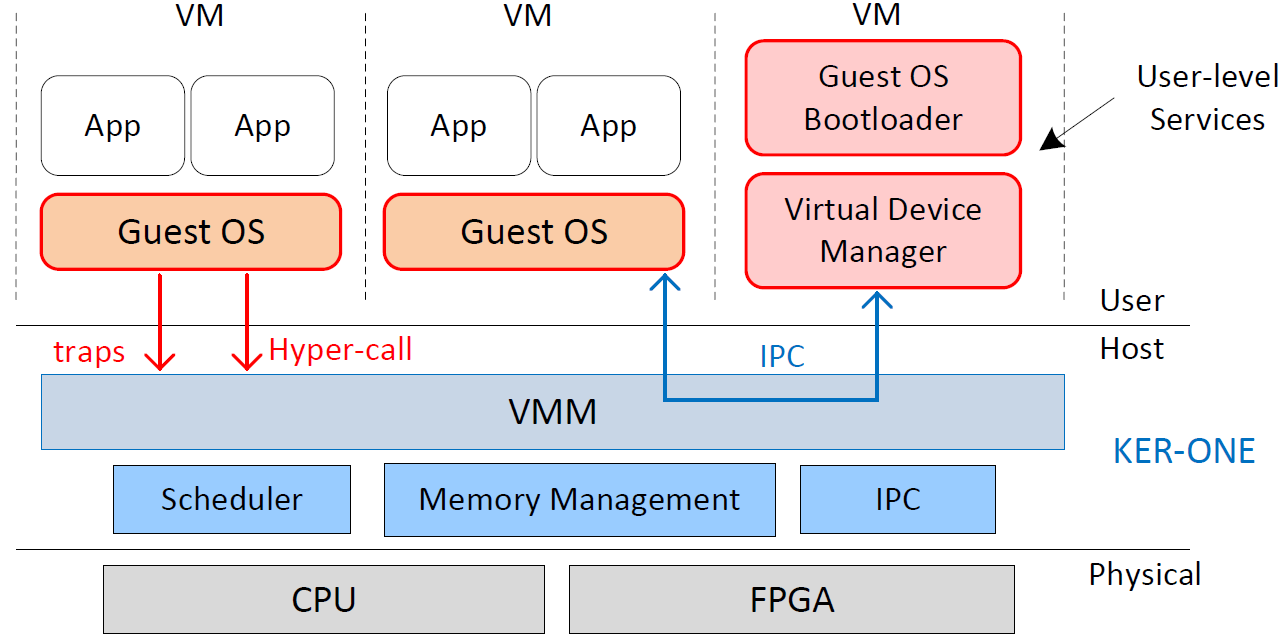My current research activities are led at the IETR laboratory, in the Syscom team.
Here are the main axis of my research :
Embedded Systems Virtualization
In order to increase flexibility in the embedded systems domain, hardware resource virtualization is currently a hot research topic. Today, numerous studies deal with resources virtualization, and the concept is well known in servers domains as well as in personal computing. Our focus targets the embedded systems and particularly communicating systems.
In this context, we have developed a custom lightweight microkernel named Ker-ONE. This microkernel provides only basic functions such as scheduling, exceptions handling, inter-process communication (IPC) and memory management, and ends up with a small Trust Computing Base (TCB).
Reconfiguration Techniques and Management
Today, wireless devices generally feature multiple Radio Access Technologies (LTE, WIFI, WIMAX …) to handle a rich variety of standards. These devices should be intelligent and autonomous enough in order to either reach a given level of performance or automatically select the best available wireless technology according to standards availability. On the hardware side, Systems on Chip (SoC) devices integrate processors and FPGA logic fabrics on the same chip with fast inter-connection. This allows designing Software/Hardware systems and implementing new techniques and methodologies that greatly improve the performance of communication systems. In these devices, Dynamic Partial Reconfiguration (DPR) constitutes a well-known technique for reconfiguring only a specific area within the FPGA while other parts continue to operate independently. To evaluate when it is advantageous to perform DPR, adaptive techniques have been proposed at IETR. They consist in reconfiguring parts of the system automatically according to different parameters.
Power Modelling of Communications Systems
Early power estimation of FPGA circuits is a major challenge in digital design. In order to tackle this issue, designers should be able to estimate power consumption very early in the design process to reduce time-to-market and development costs.
In this axis, we have proposed an efficient methodology to quickly and accurately evaluate the power consumption and performance of wireless communication base-band systems implemented in FPGAs. The methodology is realized in two steps using a low-level characterization process and high-level system modelling based on neural networks.
New Waveforms Implementation
Among the different techniques that have been used to improve the Energy Efficiency of fifth generation (5G) cellular networks, one technique consists in using spatial modulation. This technique has already provided significant performances and consists in improving spectral efficiency by using an additional spatial dimension. At IETR, new waveforms are investigated and implemented on real Hardware platforms to demonstrate the feasibility of the approach
PhD Students
- Wael Ayoub (current)
- Ye Tian (current)
- Yehya Nasser (current)
- Mohamad Rihani (current)
- Yvan Kokar (current)
- Tian Xia (2016)
- Jordane Lorandel (2015)
- Mehdi Aichouch (2013)
- Florent Camarda (2012)
- Yaset Oliva (2012)
- Sonia Khatchadourian (2010)
Research Projects
ANR Spatial Modulation (ANR PRC2015). In this project, I am responsible for the WP4 dedicated to Platform Prototyping.
ANR Trimaran (2011-2014) Time Reversal MIMO OFDM Green Communications based on MicRo-structured ANtenna) WP4 scientific Director (Proof of Concept)
ANR COMPA (2011): Model Oriented Design of Embedded and Adaptive Multiprocessor
ANR OveRSoC (2005-2009) The objective of the project was to develop a global exploration methodology to evaluate and validate the interactions between an embedded RTOS and a Reconfigurable SoC (RSoc) platform.
Cominlabs RELIASIC project
Master Students
Some of the master students that I have supervised are listed here:
Mustapha Haydar, Master 2 SISEA, université de Rennes 1: mise en oeuvre d’un système de communication numérique sur des cartes FGPA à l’aide de MATLAB (2016)
Pierre Lucas, INSA de Rennes, 5ème année (département EII) :Virtualisation de systèmes embarqués: portage d’un hyperviseur réalisé avec un cortex a9 sur une autre carte équipée d’un cortex a15 (2015)
Amine El Malki, Master 2 CTS, université de Rennes1, ISTIC, Création d’un bloc IP permettant l’estimation d’un signal OFDM(2015)
Hoang Nhu Vinh, Master 2 CTS, université de Rennes1, Mise en oeuvre d’une plateforme autour du Cloud Computing(2013)
…

